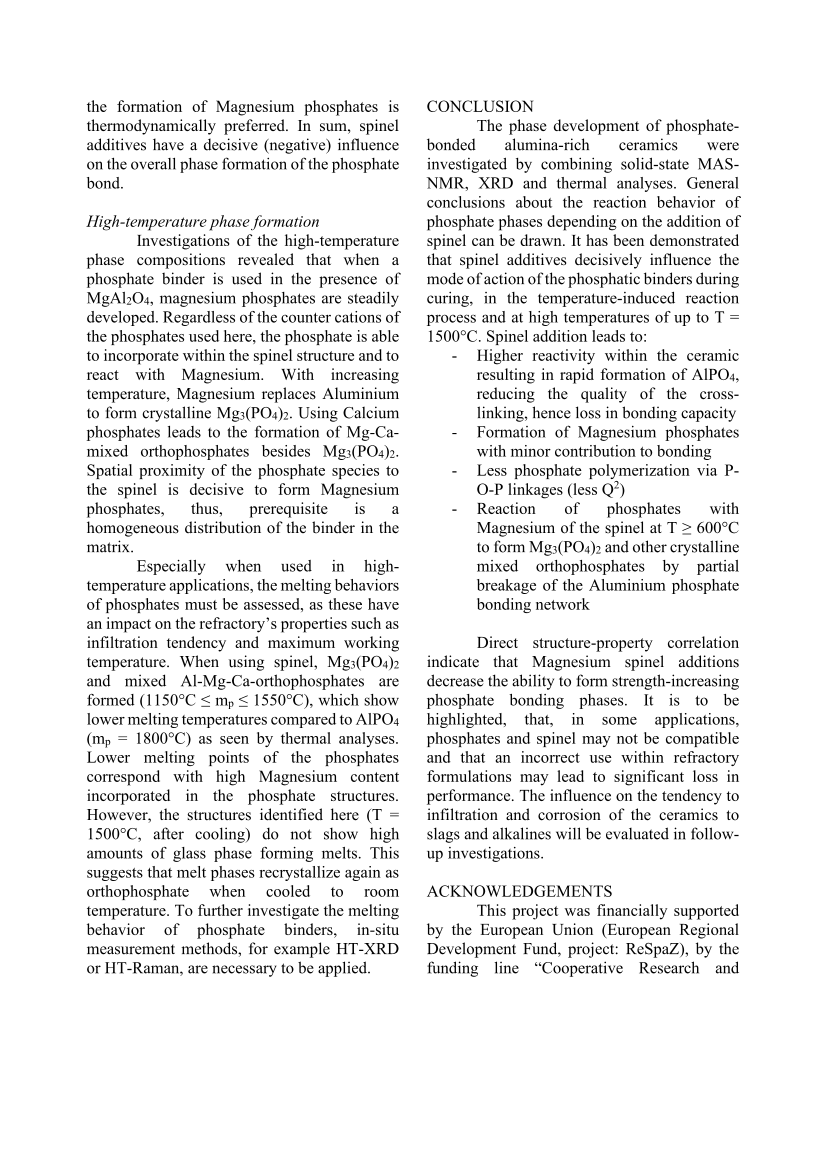the formation of Magnesium phosphates is thermodynamically preferred. In sum, spinel additives have a decisive (negative) influence on the overall phase formation of the phosphate bond. High-temperature phase formation Investigations of the high-temperature phase compositions revealed that when a phosphate binder is used in the presence of MgAl2O4, magnesium phosphates are steadily developed. Regardless of the counter cations of the phosphates used here, the phosphate is able to incorporate within the spinel structure and to react with Magnesium. With increasing temperature, Magnesium replaces Aluminium to form crystalline Mg3(PO4)2. Using Calcium phosphates leads to the formation of Mg-Ca- mixed orthophosphates besides Mg3(PO4)2. Spatial proximity of the phosphate species to the spinel is decisive to form Magnesium phosphates, thus, prerequisite is a homogeneous distribution of the binder in the matrix. Especially when used in high- temperature applications, the melting behaviors of phosphates must be assessed, as these have an impact on the refractory’s properties such as infiltration tendency and maximum working temperature. When using spinel, Mg3(PO4)2 and mixed Al-Mg-Ca-orthophosphates are formed (1150°C ≤ mp ≤ 1550°C), which show lower melting temperatures compared to AlPO4 (mp = 1800°C) as seen by thermal analyses. Lower melting points of the phosphates correspond with high Magnesium content incorporated in the phosphate structures. However, the structures identified here (T = 1500°C, after cooling) do not show high amounts of glass phase forming melts. This suggests that melt phases recrystallize again as orthophosphate when cooled to room temperature. To further investigate the melting behavior of phosphate binders, in-situ measurement methods, for example HT-XRD or HT-Raman, are necessary to be applied. CONCLUSION The phase development of phosphate- bonded alumina-rich ceramics were investigated by combining solid-state MAS- NMR, XRD and thermal analyses. General conclusions about the reaction behavior of phosphate phases depending on the addition of spinel can be drawn. It has been demonstrated that spinel additives decisively influence the mode of action of the phosphatic binders during curing, in the temperature-induced reaction process and at high temperatures of up to T = 1500°C. Spinel addition leads to: - Higher reactivity within the ceramic resulting in rapid formation of AlPO4, reducing the quality of the cross- linking, hence loss in bonding capacity - Formation of Magnesium phosphates with minor contribution to bonding - Less phosphate polymerization via P- O-P linkages (less Q2) - Reaction of phosphates with Magnesium of the spinel at T ≥ 600°C to form Mg3(PO4)2 and other crystalline mixed orthophosphates by partial breakage of the Aluminium phosphate bonding network Direct structure-property correlation indicate that Magnesium spinel additions decrease the ability to form strength-increasing phosphate bonding phases. It is to be highlighted, that, in some applications, phosphates and spinel may not be compatible and that an incorrect use within refractory formulations may lead to significant loss in performance. The influence on the tendency to infiltration and corrosion of the ceramics to slags and alkalines will be evaluated in follow- up investigations. ACKNOWLEDGEMENTS This project was financially supported by the European Union (European Regional Development Fund, project: ReSpaZ), by the funding line “Cooperative Research and
(c) 2024 American Ceramic Society. All Rights reserved.








